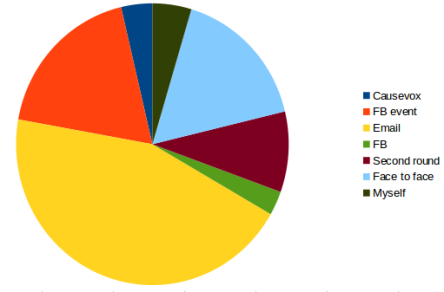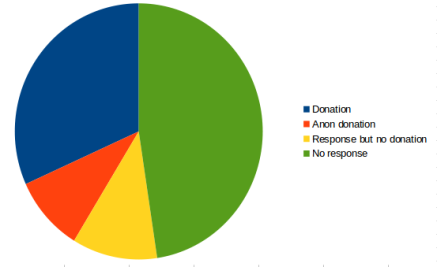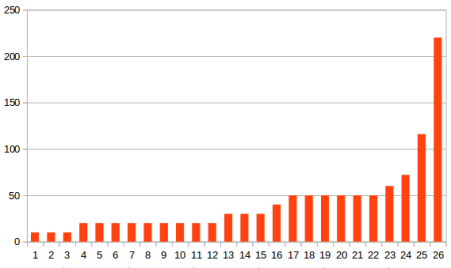Summary
There's more evidence rolling in that people who run successful birthday and Christmas fundraisers aren't wizards. Here are my own headline figures:
Money raised including matching: $2053 CAD
Money raised: $1058
People contacted: 63
This was my first time fundraising. I don't know how much time I spent on this fundraiser. It was significantly more per person than Peter Hurford, because I tend to be scared of emailing people and hence slow. As such, it was probably barely competitive with a salaried job in terms of $/hour. But it was a worthwhile comfort zone expansion for me, and I expect that next time I do this I'll be a lot more efficient about it.
Edit: My original expectation was to raise $200 (excluding matching). So I exceeded this by a factor of 5, coincidentally the same that Theron Pummer and Peter Hurford exceeded my expectation by. This suggests I'm poorly calibrated and don't update very well.
Timeline
Dec 10: Created fundraiser on Causevox, with standard text for SCI/DtWI.
Dec 20: Created Facebook event promoting my fundraiser
Dec 22-24: Sent (mostly personal) emails and facebook messages promoting my fundraiser to 30 people
Dec 27: Sent impersonal facebook messages to an additional 17 people
Jan 1: Fundraiser closed

Note: there seems to be a bug in the graph generation on Causevox - the graph doesn't include matching donations, but the target line does.
Message text
Note: Don't use this message text. Write your own so that it sounds like it comes from you.
Note: I didn't mention anything about donation matching here.
Note: I used this message text both for email and facebook communications.
Subject: Hi {name}
Hi {name},
{Something specific to that person if I could think of it, otherwise "How are things?"}
I'm in Buffalo right now for Christmas but otherwise still in Toronto with Jeannine. I've been having fun with various projects including (you won't be surprised) running a mathematics club.{modified if the person already knew this stuff}
This Christmas I'm running a charity fundraiser to help fight neglected tropical diseases.
I'm excited about Deworm the World and Schistosomiasis Control Initiative because they implement proven deworming interventions which are also very cheap. That means you can improve the health of a lot of people without spending much money! (It improves school attendance too).
If you want to donate, or are just curious, my fundraising page is here:
http://christmas.causevox.com/giles
But if you don't want to donate that's totally ok. I'd really like to stay in touch with you and catch up on how things are going.{modified if I was already communicating regularly with that person}
All the best, and merry Christmas.
Giles
Which kind of donor are they?
| Money raised | |
| People I know through EA | 110 |
| Myself | 50 |
| Friends | 948 |
| Matching | 945 |

Note: I wasn't targeting anyone that I know only through the EA movement. These people found out about the fundraiser through the Facebook event or Causevox platform.
Note: The matching funds are less than 50% of the total. Is there a problem here?
How I made contact with people
| People | Money | |
| Causevox | 2 | 40 |
| FB event | 8 | 200 |
| 22 | 482 | |
| FB | 9 | 30 |
| Second round FB | 17 | 100 |
| Face to face | 4 | 180 |
| Myself | 1 | 50 |
| Total |
63 |
Number of people:

Amount of money:

Note: Face to face and email communication appear more lucrative than facebook, but this might be because those people are closer friends rather than anything to do with how people respond to the communication medium itself.
Note: "FB event" is anyone who liked or joined my facebook event. Everyone in my network was invited to the event but I haven't counted those as having been contacted, since most people ignore FB events.
Responses

| Donation | 20 |
| Anon donation | 6 |
| Response but no donation | 7 |
| No response | 30 |
Note: all responses were positive or neutral. No-one seemed irritated at me.
Size of individual donations

Cumulative (amount of money raised from donations of size <=X):

Median: $25
Mean: $43
Donations of $20 and below accounted for 19% of funds raised.




Why was that? I feel like you may have missed a good opportunity there, but it's hard to really know.